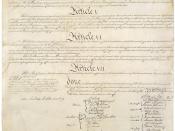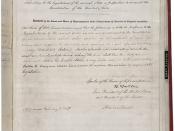The issue of separation of church and state has been greatly debated since the founding of our country and the creation of the United States Constitution. The Supreme Court has taken many cases over the years since its establishment that involve the inclusion of religious morals in school. One case that draws attention to the exploitations of the first amendment is the case of Epperson v. Arkansas. In 1968 this case was presented to the Supreme Court for a ruling on the matter of a law in Arkansas that excluded the ideas of evolution and common dissent in the schools curriculum. A teacher who was arguing that it was unconstitutional to ban the instruction of evolution brought this case forth to the Supreme Court. The courts decision was in favor of the Epperson and Justice Fortas affirmed that the law against evolution was unconstitutional because it was in violation of the first amendment.
This was ruled due to the fact that it was against the Establishment clause and banned free exercise of religion. After this case was decided states were no longer able to pass laws that barred the instruction of evolution in public schools. This action taken by the Supreme Court is a contradictory battle that involves an unfair and opinionated view on evolution and common dissent as a completely concrete science and not as a theory. The topics of evolution and common dissent that are now being required in science classes across the country are a direct violation and misuse of court power. Since common dissent cannot completely be defined and proved with evidence, how can it take priority over any religion in public schools when it is based on an inconclusive theory? Aren't all religions based on inconclusive theories about creation? So how is it possible...


